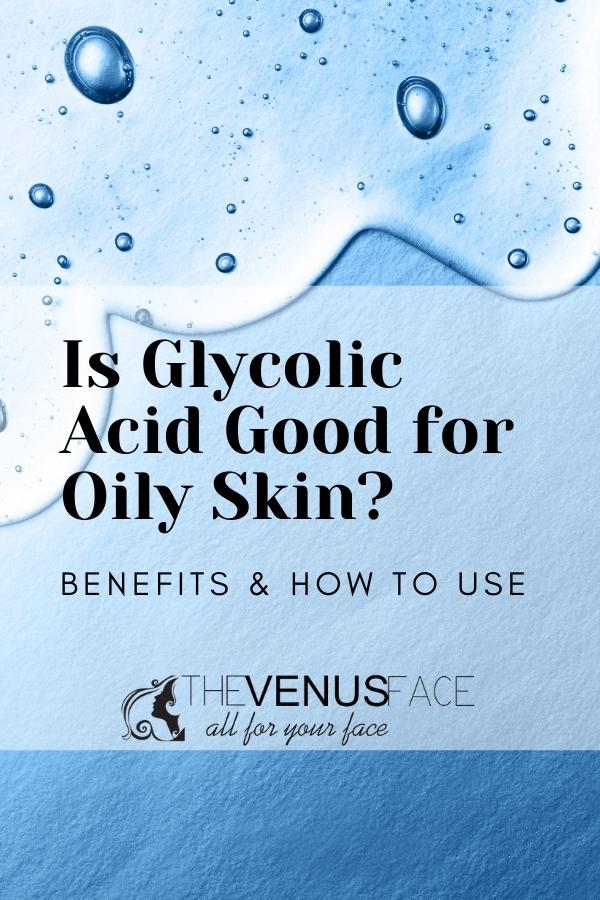Is glycolic acid good for oily skin? Read on!
People with oily skin have to deal with a lot of problems. The most common problem is that their skin is always shiny and they have to constantly blot it. They also are more prone to blackheads, whiteheads, and acne. Their makeup never seems to stay in place and they always look like they have a greasy film on their face. Even if they use the best products, their skin still looks oily. People with oily skin also have enlarged pores. This can be due to genetics or excess sebum production. The only advantage is that people with oily skin age better than dry skin, which means they have fewer wrinkles and fine lines. Because of how inconvenient it is to have oily skin, people are always looking for solutions. One popular solution is glycolic acid. Yet, do you know how good glycolic acid is for oily skin?

Does glycolic acid help oily skin?
Yes, it does. Glycolic acid is one of the most beneficial ingredients that you can use on oily skin. It is an alpha hydroxy acid (AHA) that helps to remove dead skin cells and excess oils from the surface of the skin. Thus, it is suitable for people with oily acne-prone skin.
Glycolic acid benefits for the skin
This acid is great for the skin because it can help to:
Unclog pores
This acid is commonly used in skin care products because it effectively unclogs pores and helps to improve the overall appearance of the skin. Glycolic acid works by dissolving the “glue” that holds dead skin cells together, which allows them to be sloughed off more easily.
Prevent acne
As an effective exfoliator, glycolic acid can also help to prevent acne. It does this by unclogging pores and removing excess oils from the skin. This effect is great for oily acne-prone skin since it can help to reduce the number of breakouts.
Brighten the skin
Because of how effective this acid is when it comes to removing dead skin cells, glycolic acid shows significant brightening effects on the skin. This also means that dark spots, uneven skin tone, and discoloration can be improved with regular use.
More: Homemade Face Bleach for Oily Skin to Brighten Your Complexion
Reduce wrinkles and fine lines
Thanks to its ability to stimulate collagen production, glycolic acid can help to reduce the appearance of wrinkles and fine lines. Collagen is a protein that helps to keep the skin firm and elastic, so increasing its production can help to improve the skin’s overall appearance and make wrinkles/fine lines less visible.
More: Top 5 microcurrent machines for beauty therapists.
Act as a humectant
Unlike moisturizer, which works by trapping water in the skin, glycolic acid actually helps the skin to attract and retain moisture. This is because glycolic acid is a humectant, which means that it draws moisture from the air and into the skin. This effect is ideal for oily skin since it helps to keep the skin hydrated without making it feel greasy.
How to use glycolic acid for oily skin
The most effective and easiest way to use this acid is by buying store-bought products. You can find glycolic acid in the form of cleansers, astringents, serums, moisturizers, and even masks. It is convenient because you don’t have to add an extra step to your skincare routine. Simply incorporate glycolic acid products into your existing regimen.
It is strongly recommended to use glycolic acid in the evening since it can make your skin more sensitive to sunlight.
How to make DIY glycolic acid at home
Sugar is a great source of glycolic acid. Muscovado sugar is especially rich in glycolic acid, which makes it perfect for this purpose.
Ingredient
- Muscovado sugar
- Yogurt
- Your favorite essential oil
How to make
- In a bowl, add 3 tablespoons of muscovado sugar
- Next, add 3 tablespoons of yogurt
- Then, add 5-10 drops of essential oils
- Stir the mixture well, and make it form a paste.
- If the mixture is too watery, add more sugar. If it’s too thick, add more yogurt.
How to use
To use, first wash your face with lukewarm water, then apply the mixture to your face in a circular motion and leave it on for 5-10 minutes. Then wash your face again with water. Doing this regularly should help improve your skin.
Final thought
Is glycolic acid good for oily skin? Yes, overall, glycolic acid is a great ingredient to use for oily skin. It effectively unclogs pores, prevents acne, and helps to brighten the skin. Additionally, it can reduce wrinkles and fine lines. You can easily incorporate glycolic acid products into your existing skincare routine, but it is recommended to use them in the evening since they can make your skin more sensitive to sunlight. If you want to make DIY glycolic acid at home, muscovado sugar is a great source of this beneficial ingredient.
More:
- Use Salicylic Acid for Greasy Skin
- Use Hyaluronic Acid for Greasy Skin
- Use Lactic Acid for Greasy Skin
- Use Niacinamide for Greasy Skin
F.A.Q
Is glycolic acid for dry or oily skin?
It is best for all skin types except sensitive skin.
Is glycolic acid or salicylic acid better for oily skin?
Salicylic acid is better for oily skin since it is more effective in reducing sebum production. If you want to learn more about salicylic acid, read this blog post.
Does glycolic acid bring out pimples?
No, it doesn’t. In fact, it can actually help to reduce pimples.
References: https://www.fda.gov/cosmetics/cosmetic-ingredients/alpha-hydroxy-acids


